How to Get Audio With DVI-To-HDMI Converters, Step By Step
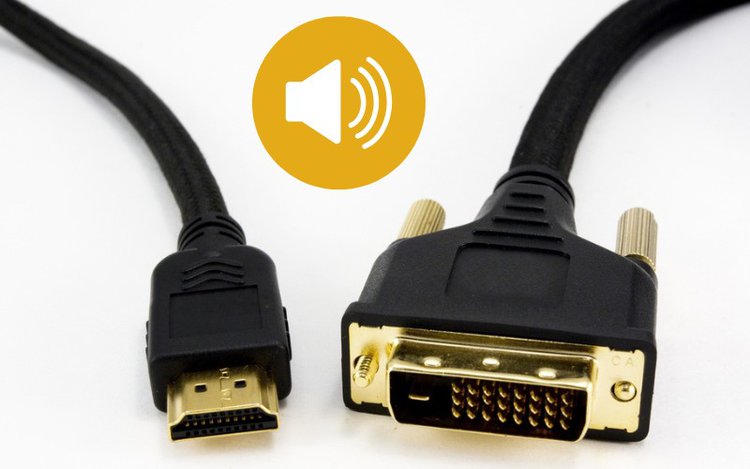
- To transmit audio when using a DVI to HDMI converter, you must use additional audio cables such as Optical/SPDIF/Toslink, 3.5mm, or RCA cables.
- DVI does not carry audio, so a separate audio connection from the source device to the speaker system is necessary.
- The type of DVI port (DVI-I, DVI-D, DVI-A) determines the specific adapter and audio cable required for connecting to HDMI displays with audio support.
DVI connections can’t carry audio, but with the right setup, you can still enjoy your media with full sound. In this article, you’ll discover simple solutions involving extra audio cables to bridge the gap.
Read on for the quick guide!
Quick Navigation
Quick Guide
|
Connection |
Materials Needed |
Setup Instructions |
| DVI-I to HDMI |
|
|
| DVI-D to HDMI |
|
|
| DVI-A to HDMI | See Materials for DVI-I to HDMI | See Setup Instructions for DVI-I to HDMI |
| HDMI to DVI |
|
|
Does DVI Carry Audio?
No, DVI does not carry audio.
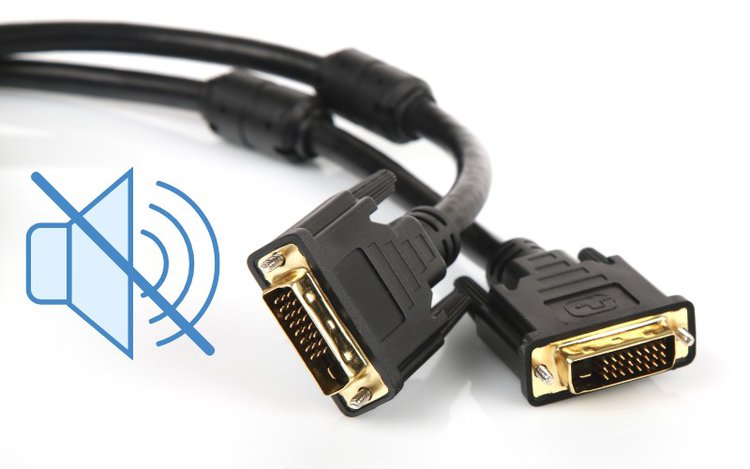
Consequently, you will need to use separate audio cables to transmit sound.
While this means you will have to purchase and connect additional cables, the entire process only takes a few seconds. Additionally, the necessary cables are usually quite affordable.
You can use the following cables to transmit audio for your DVI-to-HDMI setup.
- Optical/SPDIF/Toslink Cable
- 3.5mm Audio Cable
- RCA Audio Cable
Does a DVI to HDMI Connection Carry Audio?
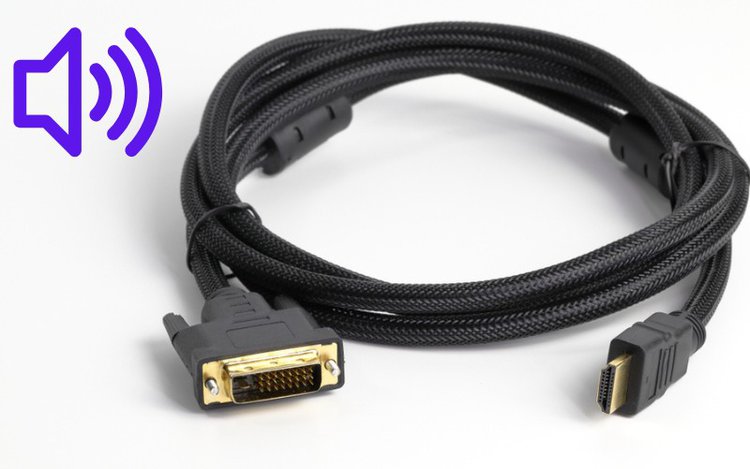
Whether a DVI to HDMI connection can carry audio will depend on which adapter you use, with some natively supporting sound and others not.
That said, you will need to use a separate connection (i.e. audio cables) to extract the DVI-compatible source device’s audio.
Let’s learn how to extract audio from your DVI-I, DVI-D, and DVI-A source device using an optical/SPDIF/Toslink, 3.5mm, or RCA audio cable.
Set Up DVI to HDMI Connections That Carry Audio
1. DVI-I to HDMI
Materials Needed
- DVI-I to HDMI Adapter
- DVI-I Cable
- Audio Cable (depends on which ports are available)
Connection Diagram
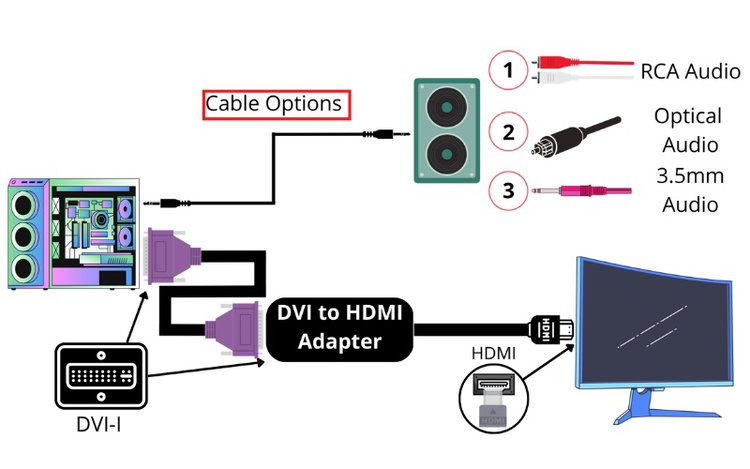
Installation and Setup
Step 1: Plug one end of your DVI cable into your source device’s DVI port, hand-screwing it in place with the locking screws to ensure a secure connection.
Step 2: Next, plug the other end of your DVI cable into your DVI to HDMI adapter, screwing it in place like you did with the other end.
You may also want to ensure your source device is connected to a stable power supply.
Step 3: Plug the DVI to HDMI adapter’s attached HDMI cable into the HDMI-compatible display’s (e.g. monitor, TV, projector) HDMI port.
Then, check that the display is plugged into an available wall outlet.
Step 4: Observe which audio out ports your source device has and select an audio cable accordingly. Then, plug one end (or two ends in the case of RCA) of your chosen audio cable into the source device’s audio port.
Step 5: Then, plug the other end of your audio cable(s) into the speaker or sound system’s audio port(s).
If needed, connect your speaker to a wall outlet with its power cord.
Step 6: Turn on your source device, display, and if applicable, speaker.
Step 7: Now, turn your attention to your source device and change its output to DVI. This process may vary depending on your source device’s settings, as you may need to press a button, turn a dial, or flip a switch.
Step 8: Then, on your display, change the input to HDMI. If your display has several HDMI ports, ensure you select the correct port (HDMI 1, 2, 3, etc.) by referring to the port’s label.
Step 9: Now, you should see the source device’s picture on your display. The picture may be extended (one singular image) or duplicated (with one image on the source device and another on the display).
Step 10: Finally, play something with audio from your source device to test if sound plays through your speakers. If you don’t hear sound coming from your speakers, check that everything is connected and powered properly, and adjust the speaker’s volume.
2. DVI-D to HDMI
Materials Needed
- DVI-D to HDMI Cable
- Audio Cable (depends on which ports are available)
Connection Diagram
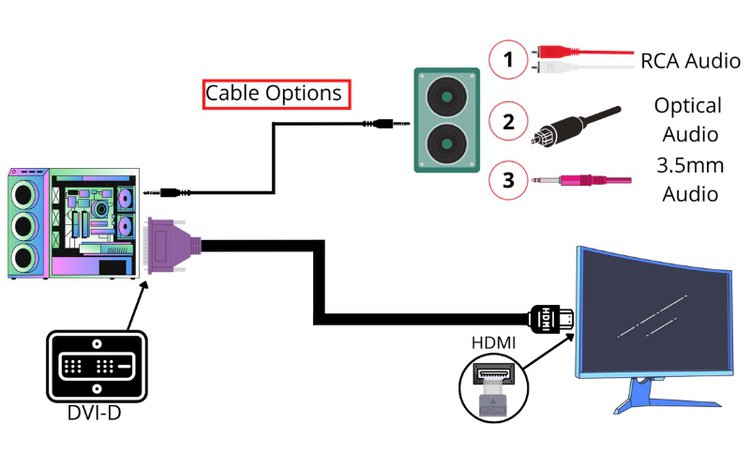
Installation and Setup
Step 1: Connect the DVI end of your DVI-D to HDMI cable to your source device’s DVI-D port. Ensure the cable’s pins are in contact with the port’s pinholes, before using the cable’s locking screws to screw it in place.
Step 2: Then, connect the DVI-D to HDMI cable to your source device’s (e.g. monitor, TV, projector) HDMI port.
Now is also a good time to check that both devices are connected to power.
Step 3: Once you’ve chosen and acquired the audio cable you want to use for your setup, connect one end of the audio cable to your source device’s respective audio port.
Step 4: Then, connect the other end of the audio cable to your speaker. If you’re using RCA cables, repeat this process for each cable, ensuring they’re plugged into their respectively colored ports.
Step 5: Now, power on your source device and display.
Step 6: Change your source device’s output to DVI so that the source’s video signal will be transmitted via its DVI port.
Step 7: Then, adjust your display’s input to HDMI.
Step 8: Once you’ve completed all of the above steps, you should be able to see your source device’s image extended or duplicated on your display. If you still can’t see an image on your display, double-check that it’s powered, turned on, and set to the correct input.
Step 9: Now, play a video or some music and observe if its audio plays through your speaker. If it doesn’t, confirm that all of the audio cables are properly connected.
Watch the video below demonstrating how to connect a source device to a display using a DVI-D to HDMI converter.
3. DVI-A to HDMI
Nowadays, DVI-A cables and ports are rarely used as they only carry analog signals, similar to VGA.
Therefore, there are no widely used methods of converting DVI-A to HDMI and, consequently, no cables, converters, or adapters made for this specific purpose.
However, we found that DVI-I to HDMI adapters are compatible with DVI-A ports, allowing users to connect them to DVI-A-supported devices.
So, if your source device has a DVI-A port, follow the instructions in the DVI-I to HDMI section found above to connect it to your HDMI-compatible display.
HDMI to DVI Setup That Carries Audio
Follow the steps below to connect an HDMI-compatible source device (game console, DVD player, laptop, etc.) to a DVI-compatible display (TV, monitor, projector).
Materials Needed
- HDMI to DVI Cable
- Audio Cable (depends on which ports are available)
Connection Diagram
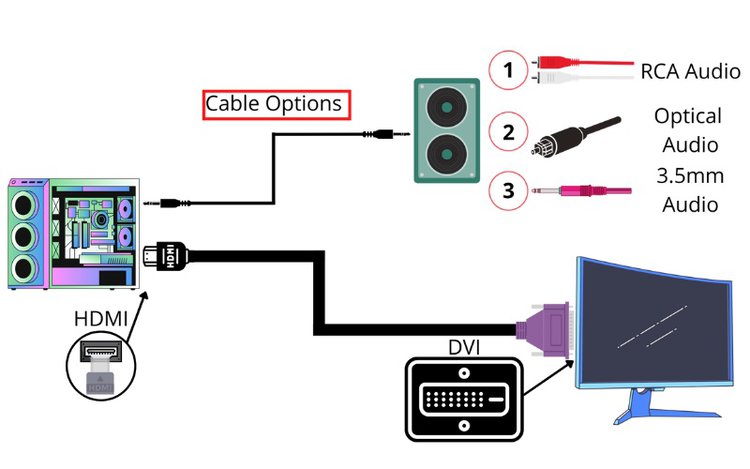
Installation and Setup
Step 1: Plug the HDMI end of the HDMI to DVI cable into your source device’s HDMI port.
It’s also a good idea to take this opportunity to connect your source device to power.
Step 2: Connect the DVI end of the same cable to your display’s DVI port. Then, make sure the cable’s pins are in contact with the port’s pinholes before tightening the locking screws.
Before proceeding to the next step, check that your display is properly powered.
Step 3: Connect one end of a compatible audio cable (or two cables if you’re using RCA) to the source device.
Remember, RCA cables are color-coded and must be plugged into their respectively colored ports.
Step 4: Then, connect the other side of the same audio cable to your speaker.
Step 5: Next, power on your source device and display. You may also need to turn on your speaker.
Step 6: Adjust the source device’s output to HDMI. If you don’t know how to adjust your source device’s output, consult the instructional manual or manufacturer’s website.
Step 7: Then, change your display’s input to DVI.
Step 8: You should now be able to see your HDMI-compatible source device’s image on your display.
Step 9: To test if your setup is working properly, play a video or some music from your source device and see if the audio is playing from the speaker.
If the audio sounds scratchy, is unstable or is not working, then ensure your cables are securely connected to their proper ports and that your speakers are not muted.
DVI Types
Which DVI to HDMI converter you’ll need to use depends on the type of DVI port your source device has. There are five different types of DVI ports, each one’s contact pins varying in size and number.
Refer to the diagram below to find out which DVI port your source device has.
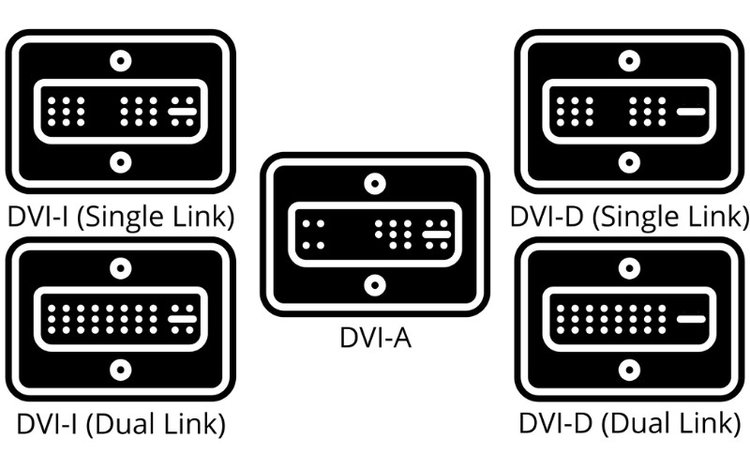
What are DVI-I, DVI-D, and DVI-A?
DVI-I
This nifty cable transmits both analog and digital signals, though it does not act as a converter for the two. This means it can connect two digital or analog sources, but not one of each.
DVI-D
This digital-only cable transmits high-quality video signals and supports better connectivity since it bypasses the digital-to-analog conversion.
DVI-A
Finally, DVI-A cables only support analog signals. While the video quality is still high, you can expect it to be slightly lower than the video transmitted via DVI-I and DVI-D cables.
This is because the video must go through the digital-to-analog conversion process, slightly reducing the final quality.
Single-Link vs. Dual-Link
DVI-I and DVI-D cables can be either single-link or dual-link. This difference not only affects the way the port looks (see diagram above), but it also affects the speed at which the signal is transmitted as well as the video quality.
Single-link cables have fewer pins and only use 12 of them when transmitting video. Meanwhile, dual-link cables have more pins and use 24 of them during the transmission process.
All DVI cables use transition-minimized differential signaling (or TMDS for short). True to its name, single-link cables use a singular TMDS transmitter and support a max resolution of 1920×1200.
On the other hand, dual-link cables use dual TMDS transmitters, which increases their max resolution to a whopping 2560×1600.
Yesenia Achlim is a technical copywriter and editor with a focus on AV equipment. She aims to break down complicated topics and make technology accessible, no matter your technical expertise. When she’s not teaching you how to replace a projector lamp, you can find her reading and baking.

